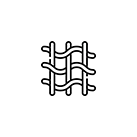Also known as Caustic Soda, Soda Ash is a powerful chemical base extensively employed across numerous industries. It is integral to manufacturing textiles, paper, soaps, and detergents, making it a prized import for every country. Caustic Soda originates from the electrolysis of a sodium chloride solution and manifests as an odorless, waxy solid at room temperature. Its chemical formula is NaOH, a combination of sodium and hydroxide ions. However, the commercial variant typically comprises sodium hydroxide monohydrate or NaOH·H2O.
Alternate Names
• Caustic Soda, a term primarily used in trading circles, highlights its corrosive and caustic attributes. This product is also known as sodium hydroxide, a name deriving from its chemical identity as a sodium hydrate.
• Known alternatively as lye and Soda, Caustic Soda owes these titles to its potent alkaline properties. Being a strong alkali or base, it is soluble in water and capable of triggering combustion in other chemicals.
• Sodium Hydroxide: Predominantly used by chemists, given its sodium ions; Caustic Soda: Popular among traders due to its corrosive nature; Lye and Soda: Names reflecting its robust alkaline qualities.
Utilization of Sodium Carbonate
• Glass Manufacturing: In the glass industry, sodium carbonate is integrated into glass formulations to lower the necessary temperature for glass production, consequently optimizing energy efficiency.
• Chemical Synthesis: This compound plays a significant role in the creation of various chemicals, including sodium bicarbonate, sodium silicate, sodium triple phosphate, sodium dichromate, sodium aluminate, and sodium cyanide.
• Paper Industry: Serving as a stabilizing agent, sodium carbonate is used to neutralize acidity in the paper industry. It also assists in de-pulping waste paper.
• Soap and Detergent Production: As an alkali, sodium carbonate facilitates the manufacturing process of soaps and detergents.
• Water Softening: The compound aids in the ion exchange process, eliminating calcium and magnesium ions from water and thereby reducing its hardness.
• Municipal Water Treatment: Soda ash is commonly introduced into city water tanks to counter the acidifying impact of chlorine and elevate pH levels.
• Dyeing: Sodium carbonate is a liaison between dyes and fibers in the textile industry.
• Food Industry: It provides pH stabilization and preservation benefits in food products.
• Electrolysis: As an electrolyte, sodium carbonate accelerates the decomposition of water.
• Toothpaste: Incorporated into toothpaste, it serves as a pH enhancer and cleaning agent.
• Brick Production: It minimizes the amount of water required in dough preparation for brick production by acting as a moistening agent.
• Textile Industry: Sodium carbonate is utilized as an anti-acid agent during silk processing.
• Petrochemicals and Crude Petroleum Refining: The compound acts as a neutralizing agent in diverse petrochemical processes.
Types of Sodium Carbonate and Their Specific Uses
• Dense Sodium Carbonate
• Light Sodium Carbonate
The distinguishing characteristics between dense and light sodium carbonate rest in their density, particle size, and specialized applications. Despite these differences, both variants share an identical chemical composition.
Heavy Sodium Carbonate
Heavy sodium carbonate, characterized by an approximate bulk density of 1000 kg/m3 and particle sizes fluctuating between 300 to 500 microns, is predominantly utilized within the glass manufacturing industry. Its larger granules help to mitigate dust and impurities, effectively reducing the risk of particle dissemination during transport.
Light Sodium Carbonate
Light sodium carbonate, with a density around 500 kg/m3 and particle sizes close to 100 microns, is primarily harnessed in producing chemicals and cleaning agents.
Diverse Forms of Caustic Soda
Caustic Soda is accessible in a plethora of forms—liquid, flakes, granules, cubes, and blocks, each designed for unique applications.
However, the liquid and flake forms often provide superior advantages. Liquid caustic Soda, mainly produced in China, is optimal for the pulp and paper industry, water and sewage treatment, and as an additive in the food industry. Manufacturers and suppliers typically offer it as a solution of 50% and 73% in water. This form’s environmental impact is minimal—when dissolved in water, sodium hydroxide decomposes into sodium and hydroxide ions, becoming neutralized. Importantly, the liquid form contributes significantly to energy efficiency, reducing energy wastage and overall costs.
On the other hand, Flake caustic Soda boasts a higher water absorption rate than its granule, cube, and block counterparts. This trait minimizes heat release, thus diminishing explosion risks. Regarding cost-effectiveness, the flake form and the liquid form present a more economical option due to its higher production rates relative to granules, cubes, and blocks.






